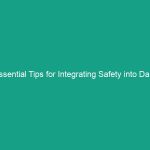Introduction
Good morning team,
Today, we’re diving into a crucial topic that affects all of us in the workplace: Essential Alarm Safety Tips. Understanding how to properly manage alarm systems is vital in enhancing our Health, Safety, and Environment (HSE) practices. Alarms are our first line of defense in emergencies, alerting us to potential dangers and helping us take immediate action. This talk aims to equip you with essential tips to avoid critical risks associated with alarm systems.
Understanding Essential Alarm Safety Tips
The term Essential Alarm Safety Tips encompasses the Best Practices and guidelines for effectively managing alarm systems in the workplace. These tips are designed to ensure that alarms function correctly and that employees know how to respond when they are triggered. Proper alarm management can significantly impact our daily operations, helping to protect our team and assets from emergencies.
Many people assume that alarms are only needed for fire emergencies, but this is a misconception. Alarms can also alert us to gas leaks, equipment malfunctions, or security breaches, making them an integral part of our safety protocols.
Key Hazards, Risks, and Safety Considerations
Ignoring alarm safety can lead to serious consequences, including injuries, property damage, and even fatalities. Here are some specific Hazards associated with alarm systems:
- False Alarms: Frequent false alarms can desensitize employees, leading to delayed responses in genuine emergencies.
- Inadequate Training: Without proper training, employees may not know how to react to alarms, increasing the risk during an actual emergency.
- Maintenance Neglect: Failing to regularly test and maintain alarm systems can result in malfunctioning alarms during critical situations.
Real-world consequences of ignoring these risks include lost time, decreased morale, and financial repercussions from workplace accidents. Therefore, it is essential to take alarm safety seriously.
Best Practices, Procedures, & Actionable Advice
To ensure alarm safety, follow these Best Practices:
1. Regular Training
Conduct regular training sessions to ensure that all employees know how to respond when an alarm sounds. This includes understanding different alarm types and their meanings.
2. Routine Testing and Maintenance
Schedule routine checks for all alarm systems to guarantee they are functioning correctly. This should include:
- Monthly testing of alarm systems
- Annual inspections by certified professionals
3. Clear Signage and Instructions
Ensure that alarm activation points and emergency exit routes are clearly marked. Display simple instructions on how to respond to different alarms in visible locations throughout the workplace.
4. Develop an Emergency Response Plan
Have a comprehensive emergency response plan that outlines the actions employees should take when an alarm sounds. Include roles and responsibilities, communication protocols, and Evacuation Procedures.
5. Encourage Reporting
Encourage employees to report any issues or concerns regarding alarm systems immediately. Open communication can prevent potential hazards from going unnoticed.
Case Study: Real-World Incident
Consider a scenario where a factory experienced a gas leak. The alarm system failed due to lack of maintenance, and employees were not trained on how to respond. As a result, the situation escalated, leading to an evacuation and significant property damage. This incident highlights the importance of regular maintenance and training in alarm safety.
Regulations, Standards, and Compliance
Compliance with safety Regulations is paramount in alarm management. Familiarize yourself with relevant Standards, such as:
- OSHA Regulations: The Occupational Safety and Health Administration sets forth guidelines to ensure Workplace Safety.
- ISO Standards: The International Organization for Standardization provides frameworks for effective alarm management.
- Company-Specific Policies: Adhere to internal policies regarding alarm systems and emergency Procedures.
Compliance protects not only you but also your coworkers, ensuring a safer work environment for everyone.
Employee Engagement & Discussion
Let’s open the floor for discussion. Here are a few questions to consider:
- What safety challenges have you encountered related to alarms in the workplace?
- How can we improve our alarm response procedures?
- Have you ever experienced a false alarm? How did it affect your response to actual emergencies?
Feel free to share your thoughts and experiences; your input is valuable in enhancing our safety practices.
Conclusion & Key Takeaways
In conclusion, understanding and implementing Essential Alarm Safety Tips is vital to maintaining a safe workplace. Remember to prioritize:
- Regular training for all employees
- Routine maintenance and testing of alarm systems
- Clear communication and signage
- Active engagement in safety discussions
By applying these practices, we can significantly reduce risks associated with alarms and create a safer working environment. Thank you all for your attention and for your commitment to prioritizing safety in our workplace.


